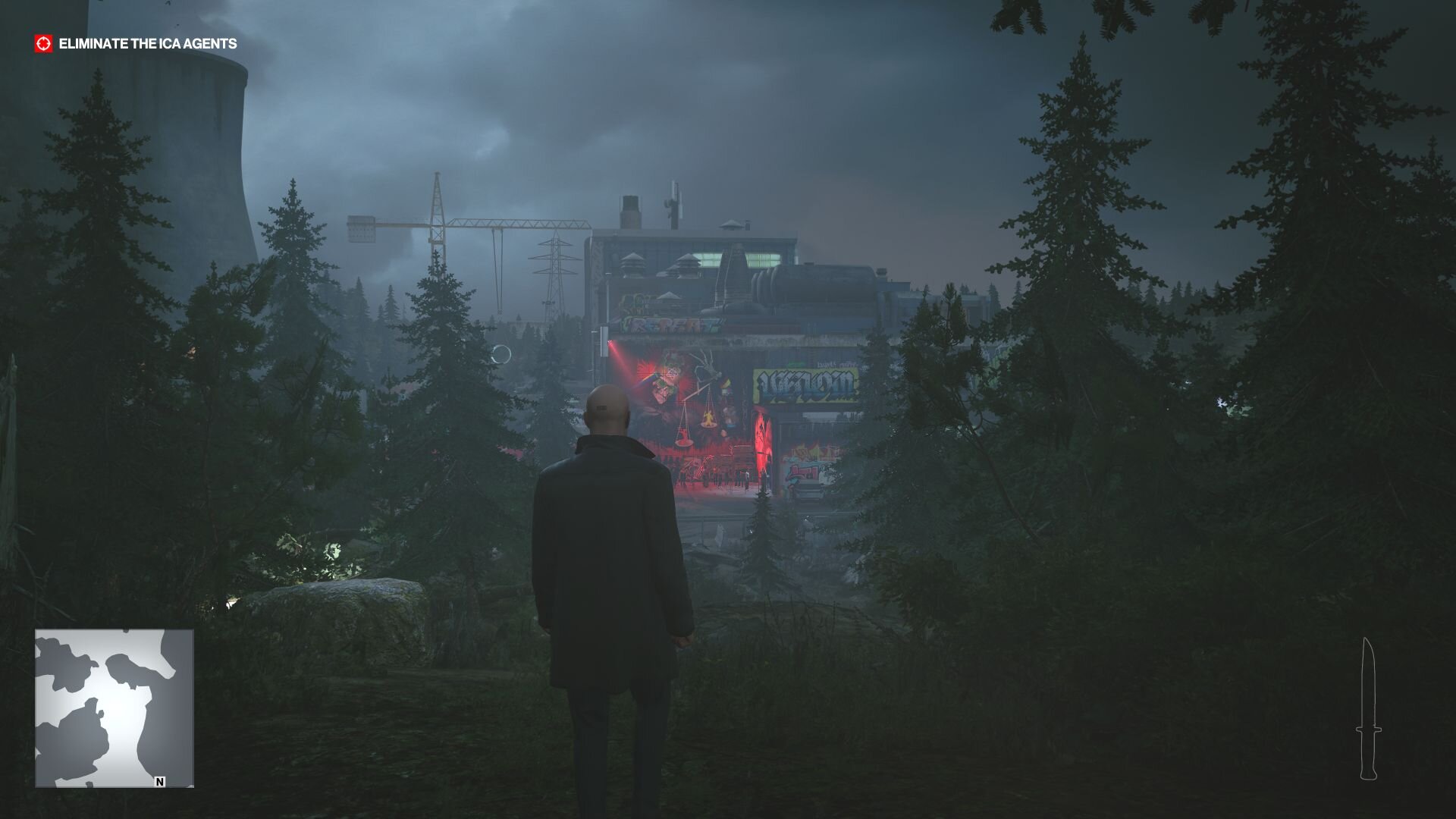Variety is the spice of death.
The Hitman franchise has certainly been an entertaining one, placing you in the shoes of an emotionless assassin, changing outfits, keeping track of NPC patterns, and finding interesting ways to eliminate your target. While Agent 47 certainly has access to a wealth of lethal weaponry, I never dived into the series for its action elements but rather for how it has you keeping to the shadows, or sometimes dressing up to get that kill face to face. Now, certain circumstances may place that action upon you, but I’ve always considered the series to be that of a stealth puzzle experience, more so than of a full-blown action game. There’s shooting sure, but if you’ve done your job right, you may not even have to kill a single soul yourself, your target included.
When IO interactive became an independent studio some years ago and retained the Hitman IP, their focus on making the games bigger and better has only succeeded from game to game. The variety and creativity in each game got more involved and intricate, giving you a wealth of options in not only how you’ll track down your target, but how you’ll dispose of them as well. Hitman III, the latest entry, is massive in scale, providing even more options and variety to make Agent 47 drastically more lethal in the process. While I thought Hitman and Hitman II were tremendous titles, I love this third entry considerably more, largely due to some clever mission variety, and the significant differences of gameplay from level to level. I never felt like I was doing the same mission in a new location, which was a problem in earlier games in the franchise. Now, that said, Hitman III does feel very similar to the previous games, sometimes too much so, but the gameplay loop IOI has created is still just as strong as ever.
Hitman III continues the story of the prior two games, as Agent 47 and his friend, Lucas Grey, begin their search for the three leaders within Providence; Alexa Carlisle, Marcus Stuyvesant, and Carl Ingram. Meanwhile, Diana Burnwood is being largely outplayed by Arthur Edwards, Providence’s Constant, a man who is seemingly two steps ahead of each major character in the game. The story wraps all of this up, putting a nail in the coffin to several aspects of its narrative, and giving Agent 47 a largely reinvented purpose by the game’s finale. While you can easily play Hitman III without playing the prior two games, you’d be doing yourself a great disservice by not, as each game is simply superb, and it will give the story that much more impact when shit starts to go down. While each mission does in a way have its own narrative to flex, each location is still tied together with a common goal as you are attempting to put an end to Providence, once and for all.
Each of the six missions has you tracking down targets to eventually set up a confrontation with Arthur Edwards, the game’s central antagonist. Missions will usually have several targets, some of which can interact with one another, but you’ll largely be tracking them down individually through a variety of means. Now, I’ve said variety a lot, and honestly, I’m likely to say it even more as that is exactly what Hitman III is at its core. Missions can become very simple if you simply beeline it for your target, shooting them in the head and then bolting away, but it’s surveying them, tracking down additional paths to even have access to them, or listening in to find unique and clever ways to place them directly in your path that the game is truly at its best. Most, if not all missions, can be completed in entirely different ways, giving you alternative methods to getting the job done that can almost make the location feel like a different level entirely, despite the locations and paths always being set.
The second mission is honestly my favorite Hitman level designed so far, as while you can go about the objective in almost any way you want, it was posing as a detective and then solving a murder within the mansion that not only placed me head to head with my target, as seen above, but it felt like I was playing a video game version of Knives Out. As the detective, I walked around, having free reign to almost anywhere I wanted to go on the grounds, interviewing suspects and piecing together clues, trying to actually solve the murder. Sure, I had to sneak out the window and tiptoe along the outside of the mansion to get into some locked rooms, but you would be fed these bread crumbs of variety in how to do your mission that just had my head spinning with ideas. Also, the game has a save anywhere feature, allowing you to get creative without losing much if any progress.
Another later mission places you at a club, hiding among the party-goers as you listen in on your earpiece you lifted from another target, getting the inside as they are panicking when more bodies start to show up. The mission gives you choice on any five targets you want, tracking them down, surveying the environment for a way to silently dispose of them. Since you can freely pick them off how you see fit, you can ignore whole chunks of the level and focus on putting down the undercover agents that occupy your view. Replaying the level allowed me to choose an entirely different path, and it honestly felt like a whole different mission. One level I’ve seen criticized across other reviews is the finale, a very linear and very non-Hitman level that honestly, was a nice change of pace with its simplicity, having Agent 47 traverse a train on his way to his final confrontation. Despite the close-quarters nature of the level, there was a lot of fun with traversing outside the train or using distractions to throw enemies off the train cars, or pulling them through the windows into the snowy abyss below.
When you complete a level, you’ll be shown a checklist of what you’ve accomplished, colorizing the methods you took, and giving you an idea of just how much variation there is in performing your objective. You’ll also unlock additional starting weapons, new weapon stashes that you’ll find littered about your next attempt at the level, as well as new starting places, such as being hired on as a chef during the mission in the mansion. This causes already completed levels to have a further sense of exploration and discovery to them, giving you the chance at new ideas, new encounters, and additional ways to silence your target. While the main story can be completed in around two sittings, depending on your session length, the variety of what is left remaining from level to level can make this a game you could sink dozens upon dozens of hours into. If you are usually a player to one and done a game, and to not revisit content once you’ve wrapped credits, then Hitman III is not a very long experience, clocking in at around 7 to 8 hours across a single playthrough.
Hitman III is a pretty damn good-looking game, even if the people that occupy each level feel a bit undercooked. IOI has taken advantage of the Series X with 4K resolution at 60 fps, with the promise of raytracing to be added in via a future update. That said, the game still looks very impressive as is. The Series S does drop the resolution down to 1080p to nail that 60fps, while the PS5 does take a small hit on resolution as well, dropping down to 3200 x 1800, while still maintaining the same texture quality as the Series X. I would say that with a few patches, we will likely see the PS5 version see a resolution boost to align it with the Series X version. Normally, when we are at the launch of new consoles, especially when it comes to smaller teams, that the limited development time with newer hardware will often see these enhancements come later as the teams get more familiar with that hardware. We are seeing titles all across the industry get patches to increase performance, adding in better framerates, resolution, and more graphically intensive things such as raytracing, and Hitman III will be no different.
HItman III offers a wealth of additional gameplay modes, as well as so many interesting ways to jump back into levels and make them feel fresh all over again. Contracts, allow the community to tailor-make levels of their own, placing targets in your path via a ton of locations that can almost make Hitman III feel as if it has a near-infinite amount of content to play through. I tinkered around with a few, seeing the vast creativity on display and some of them felt like a natural fit for most of what I’ve played across all three games. There are also the escalation missions and the upcoming elusive target modes that were some of my favorite bits of Hitman II to look forward to as well. I will stress that some bits of content are locked behind different versions of the game, but even with just purchasing the standard edition, as well as owning Hitman I and II digitally, it gave me a ton of content to enjoy without investing further.
Hitman III is the evolution of what IOI has had in store for the series, flexing their creative muscle to new heights after purchasing the Hitman IP. This game is a blast from start to finish, an experience you can often get lost in due to the massive variety in which you can solve your objectives. While there are certainly some convoluted processes in accessing older content or the constant need of being online to continue your progress naturally, they are minor issues when it comes to the raw experience of what Hitman III offers, even if it does at times feel like an expansion pack to Hitman II. With the team taking a much-needed break from the series to play around in the Bond universe, I can’t wait to see what creative ideas we will have at our fingertips in the future.
Developer - IO Interactive. Publisher - IO Interactive. Released - January 20, 2021. Available On - Xbox One/Series, PS4/PS5, Switch (Cloud), Windows, Stadia. Rated - (M) Blood. Drug Reference, Intense Violence, Strong Language.
Platform Reviewed - Xbox Series X. Review Access - Hitman III - Standard Edition was purchased by the reviewer.












